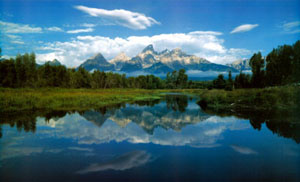| Search Art Prints | ||||||||||||||||||||
| Search Artists | ||||||||||||||||||||

|
||||||||||||||||||||
|
|
|||||||||||||||||||

Darkroom Wizardry vs.
Digital Magic
Darkroom Wizardry vs. Digital Magic
In the past, producing fine art nature photography was always a touchy combination of talent, patience, and precision. However, with the advancement of computer technology and software programs such as Photoshop, the relentless, tireless photographer who crouched in dawn’s early light to catch that particular scene is a rare find. Moreover, negatives then had to undergo a lengthy process involving chemicals and formulas and be deftly set up to dry in a darkroom. Today, with the touch of a few buttons, the same image can be produced in almost no time at all. This is the reality of modern photography. Slide film, chemicals, filters, and  darkroom techniques are falling by the wayside, thanks to digital software programs that allow the user to adjust the focus, color saturation, size, and opacity of an image without leaving the computer screen.
darkroom techniques are falling by the wayside, thanks to digital software programs that allow the user to adjust the focus, color saturation, size, and opacity of an image without leaving the computer screen.
Photography in Focus
In the days when slide film was still widely used for fine art nature photography, there were two popular brands, Fuji made Velvia, a film which was used for more vividly-colored landscapes, and Provia, which produced colors that looked more true-to-life. Photographers would choose their film according to what and how they were shooting. With the prevalence of digital cameras, film is no longer needed, being replaced by miniscule memory cards that can hold up to two gigabytes of information. Once the images are stored on the card, they can be taken to, what is now called the digital darkroom. Transferring something captured on film onto a computer involves scanning the image onto a CD, DVD, or other storage device, and then opening it in the computer as an image file. However, camera cards can simply be popped into certain computer models or quickly transferred by way of a USB cord. Once the image is in the computer, issues that would be of concern in a traditional “wet” darkroom, such as choosing the printer paper, creating the right balance of color, and maintaining proper shadows and highlights are addressed.

Color Saturation
Some believe that digital photography can make any quality of image look great, but that is a misconception. Computers may aid in the enhancement of an image, but it cannot take a poor image and turn it into a masterpiece. Color saturation in the digital age is a relatively easy concept as it simply requires clicking on a button. In the traditional darkroom, color pictures needed numerous filters, and the process had to be effected in complete darkness. Although Photoshop has improved on this, the hue/saturation command cannot be used at will; too much color and the photo could turn garish or overly colorized, like a neon sign. Photographers of the past did not have that luxury, so in trying to achieve the best lighting possible for fine art nature photography, they would usually wait for what is called the “golden hour.” Trees, flowers, rocks, and water, all seem to photograph better in the subtle glow of the setting sun.
With the prevalence of Photoshop and other software of the ilk, the level of creativity in fine art nature photography has been enhanced. Visions that were hard to achieve with the traditional methods can now be easily realized. Nonetheless, both traditional and digital photography employ talent, a certain vision and precision. It is true that working in a darkroom is not as simple as clicking on the Photoshop icon, but there is something to be said about anxiously watching an image immersed in a shallow bath slowly coming to life on a blank piece of paper.
Donovan Gauvreau
Art Historian, Donovan Gauvreau lectures about art therapy with a focus on creativity development. He believes we can learn from the great masters in art to communicate ideas and feelings through painting. He provides content for www.AaronArtPrints.org to educate and inspire people to take a glimpse into an artist's life to better understand the meaning behind their work.











